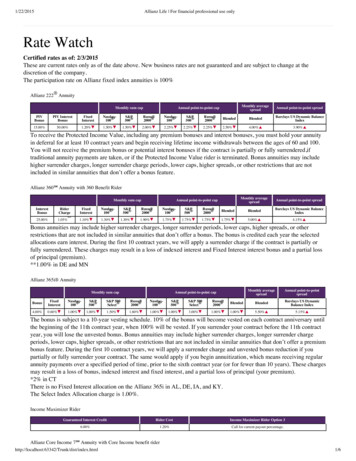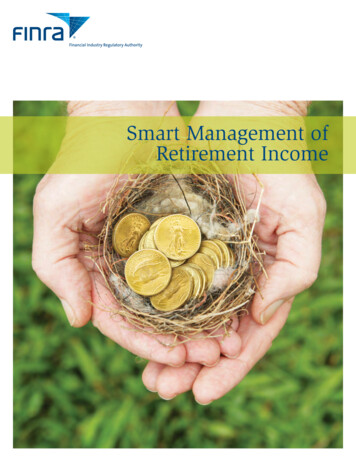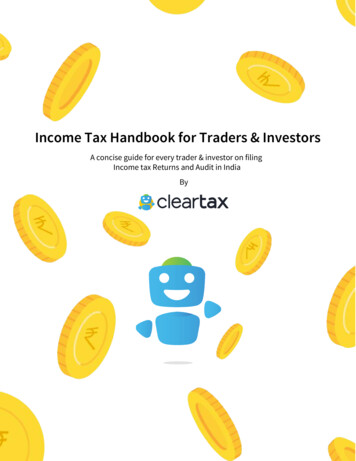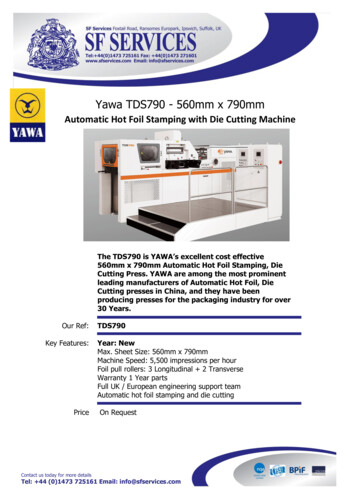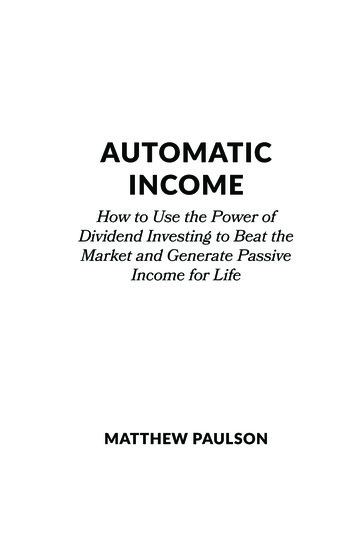
Transcription
AUTOMATICINCOMEHow to Use the Power ofDividend Investing to Beat theMarket and Generate PassiveIncome for LifeMATTHEW PAULSON
Automatic Income: How to Use the Power of Dividend Investing toBeat the Market and Generate Passive Income for LifeCopyright 2017 by Matthew Paulson. All rights reserved.No part of this book may be used or reproduced in any mannerwhatsoever without written permission except in the case of briefquotations embodied in critical articles or reviews. Please do not participate in or encourage piracy of copyrighted materials in violation ofthe author's rights.Published by American Consumer News, LLC.First edition: January 2017ISBN: 978-1539737667Cover design: Rebecca McKeeverEditing: Jennifer Harshman (HarshmanServices.com)Book Design: James Woosley (FreeAgentPress.com)Printing: Amazon CreateSpace
TABLE OF CONTENTSIntroduction.viiChapter One: The Case for Dividend Investing.1Chapter Two: Dividend Investing Basics. 15Chapter Three: How to Select Dividend Stocks. 31Chapter Four: How to Discover Great Dividend Stocks. 51Chapter Five: Taxation of Dividend Stocks. 67Chapter Six: How to Build a Dividend Stock Portfolio. 85Appendix One: Helpful Resources. 95Appendix Two: S&P Dividend Aristocrats. 97Appendix Three: Legal Disclaimers. 99Thank You.103Acknowledgments.105About the Author.107
INTRODUCTIONPREPARING FOR A SECURE retirement just isn’t aseasy it was 30 years ago. Investment returns were muchmore consistent on a year‑to‑year basis than they are today. There was no deluge of complicated investment options tochoose from. You could either invest in major public companieslike AT&T and General Electric, or you could buy one of a handful of mutual funds that were available at the time. Social Security was in the black and you didn’t have to worry about whetheror not you would actually receive the benefits promised to you.You could work for a big employer and know that if you put inthe work, you would have a secure job until the day you retired.
Automatic IncomeIn the 80s and 90s, you could simply invest in an S&P 500index fund and receive consistently good rates of return on yourmoney. Between 1980 and 1999, there were only two yearswhere the S&P 500 had a negative annual total return and theywere both pullbacks of less than 5%. You could build up a nestegg inside of an IRA or a 401K plan and know that it would consistently grow by about 10% each year. You could withdraw 4%to 5% of your portfolio each year in retirement without erodingyour portfolio value and even give yourself a raise every year inretirement to account for inflation.Unfortunately, those days are gone. Between the crash oftechnology stocks in 2000, the 9/11 attacks in 2001 and theongoing war on terrorism, the S&P 500 had three consecutiveyears of negative returns between 2000 and 2002. We had acouple of good years in the 2000s, but those returns evaporatedwhen the S&P 500 lost 37% of its value in 2008 during the GreatRecession. Major American corporations, like General Motorsand Merrill Lynch, went bankrupt. Tax revenue fell sharply andthe national debt doubled in just a few years. Interest rates fellto near zero and the government had to step in and provide anunprecedented economic stimulus to get the economy back onits feet.We have had some good years since the Great Recessionended, but the promise of working for an employer for life andsetting aside money in a 401K plan, then having a secure retirement has all but disappeared. Corporations are no longerloyal to their employees. Social Security is effectively insolvent.Financial experts are now telling us that we are going to haveto work longer and live on just 3% of our investment portfolioduring retirement.We can no longer rely on the government or big corporationsto take care of us during our retirement years. We can’t simplyviii
Matthew Paulsonthrow money at the S&P and expect to receive consistently goodreturns over the long term. These strategies may have workedfor people retiring 25 years ago, but people who are in their 20s,30s, 40s and 50s need a new investing game plan that will offerthem superior returns, consistent growth, and the opportunityfor a secure retirement.Enter Dividend InvestingWhat if I told you that there was an investment strategy thatcould provide you with a secure stream of lifetime cash flow? Ifthere was an investment strategy that would allow you to live offof 4% to 6% of your portfolio each year without having to eversell shares of stock or touch your principal, would you be interested? What if this strategy was less volatile than the S&P 500and has historically offered higher returns than the S&P 500?What if the income stream generated by this portfolio actuallygrew by 5–10% each year? Would you be interested?This investment strategy actually exists and it’s not a super‑secret hedge fund that’s only available to the ultra‑wealthy, alittle‑known strategy that will stop working as soon as everyoneknows about it, or the next Ponzi scheme waiting to unravel.This strategy is quite simple and frankly, incredibly boring—butit actually works. This miracle investment strategy is investingin dividend stocks. While it might not seem like there’s anythingall that special about companies that pay dividends, the performance numbers will change your mind.Standard and Poor’s keeps track of a list of S&P 500 companies that have grown their dividend every year for at least25 consecutive years, known as the S&P Dividend AristocratsIndex. This group of 52 companies includes household nameslike 3M, AT&T, Chevron, Coca‑Cola, Exxon Mobil, McDonald’s,Procter & Gamble and Wal‑Mart. It would be natural to thinkix
Automatic Incomethat these long‑established companies wouldn’t grow as fast asthe broader market, but actual investment returns tell a different story.The Indexology blog recently published a chart comparingthe performance of the S&P Dividend Aristocrats Index to theperformance of the S&P 500 between 1990 and 2015. While investing in the S&P 500 resulted in cumulative returns of about1,100% during this time frame, the S&P 500 Dividend Aristocrats Index had cumulative returns of more than 1,900%.During the 10‑year period ending in September 2016, theS&P Dividend Aristocrats has indexed an average annual rateof return of 10.14% while the S&P 500 Index has returned anaverage annualized rate of return of just 7.22%. No one willdeny that dividend stocks have had a good run during the lastfew decades, but what about over the long term? It turns out thatdividend payments are responsible for 40% of the annualizedreturns of the S&P 500 over the last 80 years.x
Matthew PaulsonDo I Have Your Attention Now?Dividend investing really works and you can make it workfor you, too. You can use the power of dividend investing in yourpersonal 401K plan, your IRA, and your individual brokerageaccount to create an investment portfolio of dividend‑growthstocks that will generate a steady income stream, be less volatile than the broader market, and offer returns that are superiorto the S&P 500. You can build a dividend‑stock portfolio thathas an annualized yield of 4%–6% and that yield will grow by5%–10% each year as companies raise their dividend over time.Dividend investing offers a perfect combination of income investing and growth investing. You get income from the dividendpayments you receive as well as long‑term capital gains fromprice appreciation in the stocks you invest in. If dividend stockscontinue to perform as they have over the last 10 years, it’s notunreasonable to expect an annualized rate of return of 10% inthe years to come.Just about everyone who is investing their money has thesame goal— to have enough money in savings and investmentsso that you never have to work again (if you don’t want to). Youmight want to retire at age 65 or you might want to retire earlyat age 55. Maybe you never want to retire, but you want the freedom and flexibility to work part‑time or take a job you are passionate about that doesn’t pay very well. Regardless of what yourspecific retirement goals are, dividend investing can help youachieve them. If you invest in dividend‑growth stocks throughout your working lifetime, you can simply stop reinvesting yourdividend payments at retirement and start living off the dividendpayments you receive. You may never even have to sell any of theshares of stock you own, which will allow you to leave a significant inheritance for your children and your grandchildren.xi
Automatic IncomeHow to Earn 100,000 (Or More) Per Year in RetirementLet’s imagine for a moment that you are 35 years old, aremarried, and have never saved a dime for retirement. You knowthat saving for retirement is important, but other things havejust been a higher priority. You bought a house, you had a coupleof kids, and you just never got around to opening a retirementaccount. You and your spouse decide it is time to take action andbegin planning for your future and saving for retirement.You and your spouse max out your Roth IRAs and invest 12,000 per year in dividend‑growth stocks from age 35 throughage 65. You don’t have a 401K plan through work, you don’t doany other investing, and you never increase the amount you’resaving each year. You earn an average rate of return of 10% peryear and reinvest your dividends along the way. At age 65, youwould have a total 2.26 million in your retirement account. Ifyour portfolio were to have a dividend yield of 4.5%, you wouldreceive 101,700 in dividend payments each year.By simply maxing out your Roth IRAs and investing in dividend stocks for part of your working lifetime, you can have aretirement portfolio that will generate 100,000 per year individends. You won’t have to sell a single share of stock duringretirement to pay for your lifestyle. You won’t have to take apart‑time job as a greeter at Wal‑Mart, and you won’t have torely on the government paying you the Social Security paymentsyou’ve been promised. Unlike most Americans, who retire broke,you’ll have a steady stream of cash deposits coming into yourbrokerage account each month from great American companieslike Johnson & Johnson, Coca‑Cola, General Electric, Verizon,Wal‑Mart, and Wells Fargo.xii
Matthew PaulsonI Love Dividend InvestingIn my role as the founder of MarketBeat.com, a financial‑news service that makes real‑time financial informationavailable to investors at all levels, I have been looking for an investment strategy for the last six years that I could wholeheartedly recommend to the 425,000 people who subscribe to ourdaily newsletter. I evaluated the performance of just about everytried‑and‑true investment strategy and every hot new asset allocation only. Almost without exception, every portfolio I looked atoffered unremarkable returns, would only work well in certainmarket conditions, or simply couldn’t stand the test of time.The only investment strategy I have found that has historically offered superior returns and has stood the test of time isdividend‑growth investing, which is the strategy I use in my ownpersonal investment portfolio. My portfolio currently contains30 dividend‑growth stocks and a few other income‑generatinginvestments. My brokerage account currently has a dividendyield of 4.45% and the companies I invest in have raised theirdividends by an average of 7.3% over the last several years. Ifmy portfolio companies continue to raise their dividends at theircurrent rate, I’ll be receiving a 9% dividend yield on my originalinvestment after 10 years and an 18.2% dividend yield on myoriginal investment after 20 years. My portfolio also happens tobe 30% less volatile than the S&P 500 (as measured by beta)and has outperformed the S&P 500 since I started tracking mypersonal performance about three years ago.I know what you’re thinking: “Just tell me what companiesyou bought!” I have provided a list of ticker symbols for the companies I own in one of the appendixes for full disclosure purposes, but that does not mean you should just go and buy thosestocks. The purpose of this book is not to recommend any specific dividend stocks or suggest the companies that I currentlyxiii
Automatic Incomeown are superior to the broader market or will offer above‑average returns in the years to come. Don’t just blindly copy someone else’s portfolio. The way to do well with dividend investingis to do your own research, understand the characteristics ofhigh‑quality dividend stocks, and build a portfolio of solid dividend‑growth companies.What You’ll LearnThis book is designed to be a primer for anyone looking tolearn about dividend investing. It assumes you have a basic understanding of what stocks are and how the stock market works,but is very accessible to anyone who’s just getting started. Here’swhat you’ll learn in this book: The Case for Dividend Investing (Chapter 1) – You’lllearn why investing in dividend stocks is arguably thebest way to invest in the stock market. You’ll learn howinvesting in dividend stocks compares to investing inbroad‑market indexes. You’ll learn about how riskydividend stocks are relative to other investments. Dividend Investing Basics (Chapter 2) – You’ll learnall of the terminology relevant to dividend investors.You’ll learn how announcement dates, ex‑dividenddates, record dates, and payable dates work. You’lllearn about common types of dividend stocks, suchas blue chips, real‑estate investment trusts, utilities,master limited partnerships, royalty trusts, andbusiness‑development companies. Evaluating Dividend Stocks (Chapter 3) – You’lllearn to tell high‑quality dividend stocks from the restof the pack. You’ll learn why you shouldn’t alwaysinvest in the highest‑yielding companies. You’ll learnhow to evaluate the stability of a company’s dividendand its possibilities for long‑term growth. We’ll also goxiv
Matthew Paulsonthrough and analyze several stocks so that you can putyour newly found research skills into practice. How to Discover Great Dividend Stocks (Chapter4) – You’ll learn what websites, newsletters, andresearch tools I use personally to identify, research,and evaluate dividend stocks. You’ll learn moreabout the S&P Dividend Aristocrats Index and otherlists of stocks with long track records of dividendgrowth. You’ll also learn several shortcuts to identifycompanies that pay great dividends and have stronglong‑term growth potential. Tax Implications of Dividend Investing (Chapter 5) –Not all dividend payments receive equal tax treatment.You’ll learn which types of companies’ dividends willbe taxed at capital‑gains rates and which will be taxedat your ordinary income rates. You’ll also learn howto invest in dividend stocks inside of a retirementaccount. How to Build a Dividend Stock Portfolio (Chapter6) – We’ll put everything together in this chapter andshow you how to build your very own investmentportfolio of dividend stocks. You’ll learn whether youshould invest in a dividend‑growth mutual fund or ETFor whether you should buy individual dividend stocks.You’ll learn if you should reinvest your dividends or ifyou should ever sell any of your dividend stocks. You’llalso learn how to actually start living off your dividendstock portfolio in retirement.Of course, I don’t expect that this will be the only book ondividends that you ever read. In Appendix One, I’ve included anumber of books, newsletters, and websites that you can readto learn more about dividend investing. In Appendix Two, I’vexv
Automatic Incomeincluded a list of the companies on the S&P Dividend Aristocrats Index so that you have a starting point for your research.Appendix Three contains a legal disclaimer and disclosure ofthe dividend stocks that are currently in my portfolio.Let’s Get StartedThe best time to start building your portfolio of dividend‑growth companies was five years ago, but the second besttime is today. It’s never too early or too late to start investing.Every month that you let go by without saving for retirementis a month of missed dividend payments and missed capital appreciation.Make a decision today that you are going to take control ofyour future and begin building your investment portfolio of dividend‑growth stocks.Take the first step toward planning a more secure retirement by reading the remainder of this book and learning how toevaluate and invest in dividend stocks.xvi
CHAPTER ONEThe Case for Dividend InvestingBEFORE DIVING INTO THE fine details of dividend investing, it’s worth taking a step back and thinking aboutwhat goals you are actually trying to accomplish throughinvesting and how you might best achieve those goals. If you’relike most people, you’re dependent on the month‑to‑month income provided by your day job or your business. If you were tolose your job or if your business were to fail, you would be in aworld of hurt after a few months. The goal is to set aside moneyfor the future inside of IRAs and 401K plans so that you don’thave to continue to earn a paycheck in retirement. If you builda big‑enough nest egg, you can live entirely off the money generated by investments and won’t have to work a part‑time job tosupplement your income in retirement.
Automatic IncomeThe concept of putting money away to live on during retirement is pretty basic, but most people are miserable failures whenit comes to saving retirement. Thirty-three percent of Americanshave literally nothing saved for retirement, according to a studyfrom GoBankingRates. Sixty-six percent of all Americans haveless than 50,000 set aside for retirement, which will cover 1–2years of retirement at most. Only 13% of Americans have setaside 300,000 or more for retirement. If you are part of thevast majority of Americans that aren’t saving enough for retirement, get ready to work a part‑time job and eat beans and ricein retirement. Instead of playing with your grandchildren, takinglife easily, and traveling around the world, you’ll be stuck stocking shelves in a grocery store or greeting people as they comeinto Wal‑Mart. If that’s you, I implore you to start investing todayso that you can have a better future in retirement.Dividend Stocks Work Great for Retirement InvestingAfter you open up an IRA or set up a 401K plan throughyour employer, you have to decide what kind of investments youwant to put your money into. If you’re younger, the standard advice is to put money away into growth stocks that have a goodchance to appreciate over time as you get closer to retirement.You will probably do okay owning growth stocks throughoutyour working years, but they are non‑ideal investments if you’rein retirement because you have to sell shares of the stocks ormutual funds you own to provide for your life‑style. This mightwork okay when the market is doing well, but selling shares ina declining market will magnify the impacts of market losses.If the market declines by 2% in a year, you have to sell sharesthat were worth 62,500 a year ago to get 50,000 in cash. Thiseffect, known as reverse dollar‑cost averaging, means the market will need a significantly stronger recovery to get you back to2
Matthew Paulsonyour original account balance. For example, if the market wereto decline by 20% per year and you withdraw 4% of your moneyin a year, you will actually need a 31.6% recovery to get back toyour original portfolio balance.For people getting ready to retire, the standard advice is topurchase lower‑risk, income‑generating investments such asmunicipal bonds, corporate bonds, and treasury bills. These investments provide stability and the type of steady income streamthat retirees are looking for, but they just aren’t able to generatethe yields retirees need in the current protracted low‑interestrate environment. As I write this chapter, a 10‑year Treasurybill pays a yield of just 1.7%. The iShares National MunicipalBond Fund, the largest municipal bond fund, currently pays adividend yield of just 2.26%. Since most retirees are looking tobe able to safely live on at least 4% of their retirement portfolioeach year, traditional income investments just aren’t going to cutit until the prevailing interest rates rise to more historical levels.Dividend stocks offer the perfect mix of growth investing andincome investing. You can build a portfolio of dividend stocksthat offers immediate income in the form of dividend paymentsand long‑term capital appreciation as the prices of your stocksrise over time. You can easily build a portfolio of dividend stocksthat offer a yield by 4% and 5% in today’s environment, whichwill enable you to meet the target 4% withdrawal rate in retirement. You will also never have to sell any shares of the stocksthat you own, because 100% of your withdrawals will be fundedby the dividend payments that you receive. Since you’re never actually selling any of your shares, you won’t get hammered by theeffects of reverse dollar‑cost averaging in the event of a m arketdip.Dividend stocks offer true passive income. You receivechecks in the mail (or deposits in your brokerage account) every3
Automatic Incomemonth or every quarter for simply owning a publicly traded company. You don’t have to do anything other than continue to holdon to your stocks. Because companies regularly raise their dividends, the passive income you receive in the form of dividendpayments will almost certainly grow over time. There is also noguessing about how much money you can or cannot safely takeout of your account, because you can immediately know howmuch income you can live off of by adding up the amount ofdividend payments you expect to receive over the course of theyear. Dividend investing isn’t without risk, but the combinationof capital appreciation and income they offer make them veryattractive investments for retirement.Dividend Stocks Have Lower VolatilityInvestors use a metric known as beta to determine the volatility, or systematic risk, of any given company relative to themarket as a whole. Beta identifies the tendency of a company’sreturns and price swings to track with the broader market. TheS&P 500 has a beta of 1.0. Companies that move with the market will also have a beta of 1.0. Companies that have a beta ofless than one are theoretically less volatile than the broadermarket. Securities that have a beta of greater than one are morevolatile than the market as a whole. Most technology stockshave a beta higher than one because they are higher‑risk andhigher‑growth investments. On the other hand, companies inmore stable sectors, such as utilities and consumer staples, willgenerally have betas of less than one. For example, iShares U.S.Utilities ETF has a beta of just 0.08. That means for every 1.00price swing in the S&P 500, the iShares U.S. Utilities ETF willmove about 8 cents.As you might expect, dividend stocks are collectively lessvolatile and have less systematic risk than the broader market.4
Matthew PaulsonMost companies that pay dividends and continue to grow themover time are well established large‑cap companies that havelong histories of earnings growth. They have more predictableearnings and tend to weather uncertain times better. Duringmarket dips, dividend stocks generally don’t fall nearly as muchas younger, high‑growth companies do. For example, the ProShares S&P 500 Dividend Aristocrats ETF (NOBL), whichtracks the S&P Dividend Aristocrats Index, has a beta of 0.77.If you were to own all of the companies in the S&P DividendAristocrats, your portfolio would be 23% less volatile than theS&P 500.Having a portfolio with lower volatility won’t give you betterreturns, but it will help you sleep better at night. Many investorsmake the mistake of selling when the market is in decline toavoid further losses and only get back into the market after it’salready significantly appreciated in value. By owning stocks thatdon’t jump around as much, you’ll have much less of a temptation to sell out your positions when there’s a market decline.The Psychological Advantage of Dividend InvestingDividend stocks have another psychological advantage aswell. In lieu of worrying about the day‑to‑day value of your portfolio, focus on the perpetually growing income stream you receivein the form of dividend payments. By changing the metric thatyou focus on from something that is very volatile to somethingthat will generally move up and to the right, you will be muchless tempted to sell your shares during a market decline. Youreally should be focusing on the amount of income generated byyour portfolio anyway, because the amount of income your portfolio generates is really the metric that will matter in retirement.In Warren Buffet’s 2013 annual letter to Berkshire Hathawayshareholders, Buffet told a story about a 400‑acre farm he5
Automatic Income urchased for his son in 1986. I won’t repeat the story in itspentirety, but Buffet used the example of his farm to provide aworld‑class commentary about why investors shouldn’t focus onthe wildly fluctuating valuations of stocks:. . . If a moody fellow with a farm bordering my propertyyelled out a price every day to me at which he would ei‑ther buy my farm or sell me his—and those prices variedwidely over short periods of time depending on his men‑tal state—how in the world could I be other than bene‑fited by his erratic behavior? If his daily shout‑out wasridiculously low, and I had some spare cash, I would buyhis farm. If the number he yelled was absurdly high, Icould either sell to him or just go on farming.Owners of stocks, however, too often let the capriciousand often irrational behavior of their fellow ownerscause them to behave irrationally as well. Because thereis so much chatter about markets, the economy, interestrates, price behavior of stocks, etc., some investors be‑lieve it is important to listen to pundits—and, worse yet,important to consider acting upon their comments.Those people who can sit quietly for decades when theyown a farm or apartment house too often become fre‑netic when they are exposed to a stream of stock quo‑tations and accompanying commentators delivering animplied message of “Don’t just sit there, do something.”For these investors, liquidity is transformed from the un‑qualified benefit it should be to a curse.A “flash crash” or some other extreme market fluctua‑tion can’t hurt an investor any more than an erratic and6
Matthew Paulsonmouthy neighbor can hurt Buffet’s farm investment. In‑deed, tumbling markets can be helpful to the true inves‑tor if he has cash available when prices get far out ofline with values. A climate of fear is your friend wheninvesting; a euphoric world is your enemy.During the extraordinary financial panic that occurredlate in 2008, I never gave a thought to selling my farmor New York real estate, even though a severe recessionwas clearly brewing. And, if I had owned 100% of a solidbusiness with good long‑term prospects, it would havebeen foolish for me to even consider dumping it. So whywould I have sold my stocks that were small participa‑tions in wonderful businesses? True, any one of themmight eventually disappoint, but as a group they werecertain to do well. Could anyone really believe the earthwas going to swallow up the incredible productive assetsand unlimited human ingenuity existing in America?(source: df)Dividend Stocks Outperform the MarketJ.P. Morgan Asset Management issued a report in 2013 thatanalyzed how companies that pay dividends performed compared to companies that don’t pay dividends over a 40‑year period. From January 31st, 1972, to December 31st, 2012, companiesthat paid no dividends had average annual returns of just 1.6%.Companies that cut or eliminated their dividends had averageannual returns of -0.3%. On the other hand, companies that initiated or grew their dividends during that 40‑year window sawaverage annual returns of 9.5% 323361441857 journey spring 2013speaking investments.pdf).7
Automatic IncomeIt shouldn’t be much of a surprise that companies that payand grow their dividends have outperformed that companiesthat don’t, since 40% of returns of the S&P 500 over the last80 years have come from dividend payments. Let’s imagine thatyou invested 10,000 into an S&P 500 Index fund at its inception in 1926. If you had reinvested all of the dividend paymentsyou received, your portfolio value would have grown by an average of 10.4% per year and would be worth 33,100,000 by theend of 2007. If you had not reinvested your dividends, your portfolio would have grown just 6.1% per year and would only beworth 1,200,000 at the end of 2007. During the 81‑year periodbetween 1926 and 2007, reinvested dividend income accounted for nearly 95% of the compound long‑term return earned bycompanies in the S&P 500 ome.html).If you need further proof that companies that pay strong dividends regularly outperform the market, you need not look further than the S&P 500 Dividend Aristocrats Index. This groupof 52 S&P 500 companies that have raised their dividend everyyear for at least 25 years has dramatically outperformed othermarket indexes over the last decade. During the 10‑year period ending in September 2016, the S
Dividend investing offers a perfect combination of income in-vesting and growth investing. You get income from the dividend payments you receive as well as long-term capital gains from price appreciation in the stocks you invest in. If dividend stocks continue




